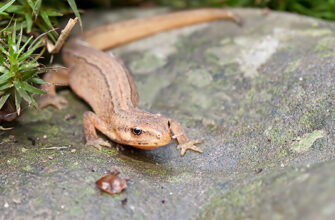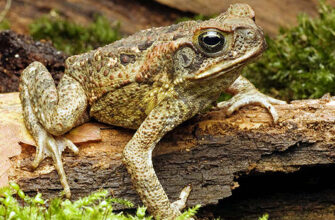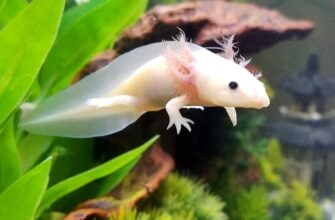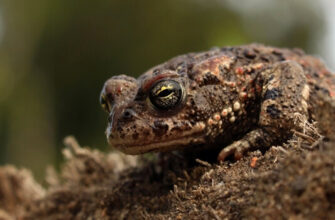Pipa is one of the most amazing frogs, found mainly in South America, in the Amazon River basin. One of the unique features of this toad is that it can bear offspring on its back for 3 months. It is for this feature that pipu is called “the best mother” by zoologists.
Origin of the species and description
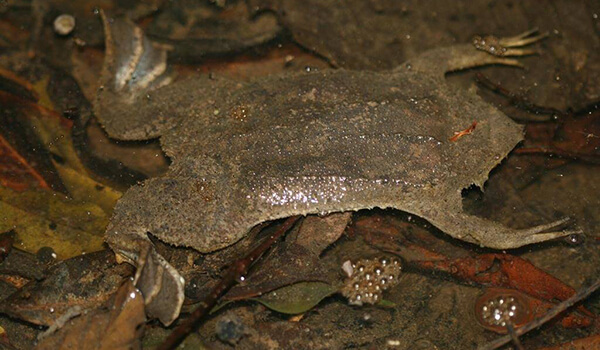
Photo: Pipa
Pipa’s head is triangular in shape and exactly the same flattened as the whole body of this tropical frog. The eyes are located on top of the muzzle, they are devoid of eyelids and are very small in size. One of the most interesting features of the gastrointestinal tract is the lack of teeth and tongue in these animals. Instead, the digestive organs are modified skin flaps located at the corners of the mouth. They look somewhat like tentacles.
Video: Pipa
Another significant difference from all other frogs — the front legs of this amphibian do not have membranes at their end and end with elongated fingers. And what is even more surprising is that they do not have claws, which distinguishes the Surinamese pipa in general from all higher animals. But on the hind limbs there are skin folds, they differ in their power and are located between the fingers. These folds make the movement of the frog under water very confident.
The body length of the Surinamese pipa almost never exceeds 20 cm. Rarely, when giant individuals are found, the length of which reaches 22-23 cm. The skin of this animal is very rough and wrinkled in its structure, sometimes black spots can be seen on the back. One of the most significant evolutionary “achievements” that allows the Surinamese pipa to adapt to environmental conditions is its dim (unlike the vast majority of tropical frogs) color. These frogs have gray-brown skin and a light belly.
Often there is a dark strip that goes up to the throat and covers the neck of the toad, thus forming a border on it. The sharp, unpleasant smell of an already unattractive animal (the “aroma” resembles hydrogen sulfide) is also a deterrent to potential predators.
Appearance and features
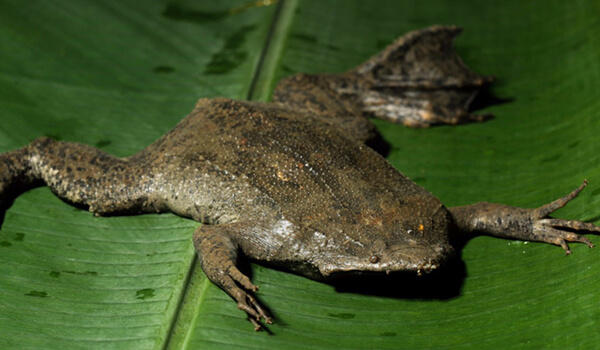
Photo: What a pipa looks like
Pipa belongs to the class of amphibians, the pipa family. Specific unique features begin already at this stage – even compared to its relatives, the pipa has a lot of differences, because of which many zoologists, when they first encountered this outlandish animal, generally doubted whether it was a frog. So, the first significant difference from all other amphibians (and frogs in particular) is its special physique.
For the first time, noticing a flat frog, the thought arises that she was very unlucky, because she looks like the skating rink rode on top, and several times. Her body in its shape resembles a leaf fallen from some tropical tree, because it is thin and flattened. And without knowing all the subtleties, it is very problematic to even admit that in front of you is not a fallen leaf, but a living creature from a warm-water tropical river.
These amphibians almost never leave the aquatic environment. Yes, in the dry season they can move to bodies of water that have not yet dried up, and apart from the sharply changed weather conditions, nothing will ever frighten these homebodies from their place. Pipa in general is a good example of the impact of evolution on the animal organism – due to the long life under water, the eyes of these amphibians became small and lost their eyelids, atrophy of the tongue and tympanic septum occurred.
The Surinamese pipa, which lives in the Amazon basin, was most aptly described by the writer Gerald Durrell in his work Three Tickets to Adventure. There are the following lines: “He opened his palms, and a rather strange and ugly animal appeared before my eyes. Yes, in appearance it looked like a brown toad that was under pressure.
Her short and thin legs were well-placed at the corners of a square body that looked like rigor mortis was reluctantly recalled. The shape of her muzzle was sharp, her eyes were small, and the shape of a pipa resembled a pancake.
Where does the pipa live?
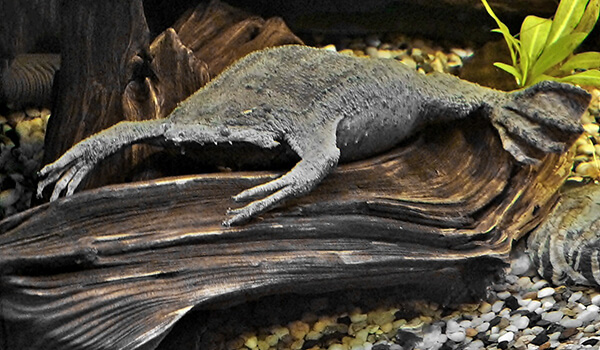
Photo: Pipa Frog
The preferred habitat of this frog is water with warm and muddy water, not characterized by a strong current. Moreover, the proximity to a person does not frighten her – Surinamese pips settle near human settlements, they are often seen not far from plantations (mainly in irrigation canals). The animal simply loves the muddy bottom – by and large, the layer of silt is the place of residence for it.
Such amazing creatures inhabit the territory of Brazil, Peru, Bolivia and Suriname. There they are considered “reigning amphibians of all fresh water bodies” & # 8212; Surinamese pips lead an exclusively aquatic lifestyle. These frogs can be easily seen not only in all kinds of ponds and rivers, but also in irrigation canals located on plantations.
Even a long period of drought is not able to make them crawl out onto solid ground – pips prefer to sit out in half-dried puddles . But along with the rainy season, a real expanse begins for them – the frogs fully take their souls away, moving with the flow of rainwater through the forests flooded by showers.
The more surprising is such a strong love of Surinamese pips for water, given that these animals have well-developed lungs and rough, keratinized skin (these signs are more characteristic of terrestrial animals). Their body resembles a small flat 4-coal leaf with sharp corners on the sides. The place of transition of the head to the body is practically not expressed in any way. The eyes are constantly looking up.
Another habitat for Surinamese pipas is human aquariums. Despite the not very attractive appearance and the outgoing smell of hydrogen sulfide, people who are fond of exotic animals are happy to breed these mysterious frogs at home. They unanimously argue that it is very interesting and informative to follow the process of gestation of larvae by the female and the subsequent birth of tadpoles.
In the event that, after reading the article, you feel sympathy for the Surinamese pipa and firmly decide to have such a frog at home, then immediately prepare a large aquarium. One amphibian should have at least 100 liters of water. For each subsequent individual – a similar volume. Why, it turns out that the Surinamese pipa gets used to any conditions only in the wild. In captivity, she experiences severe stress, and in order for this animal to give birth, it is necessary to provide a number of conditions.
These include:
- ensuring constant oxygen saturation of the aquarium;
- constant temperature. Fluctuations in values are allowed in the range from 28C to 24C;
- diet variety. These frogs need to be fed not only with dried food for the aquarium fauna, but also with earthworms, waterfowl larvae and pieces of fresh fish.
In order for the Surinamese pipa living in the aquarium to feel as comfortable as possible, sand with fine gravel and live algae should be poured at the bottom.
What does the pipa eat?
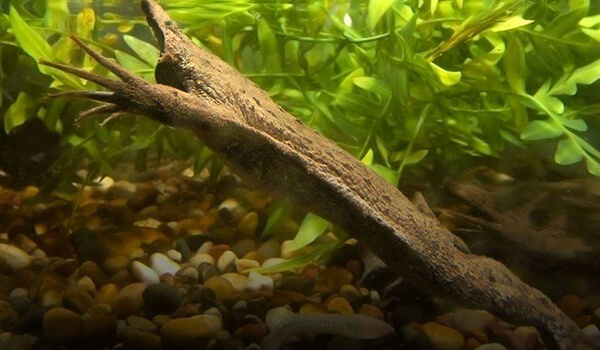
Photo: Pipa in the water
With its powerful and long fingers located on the front paws, the toad loosens the soil and looks for food, and then sends it to the mouth. She helps herself in such a noble process with growths on her paws. Given the fact that they vaguely resemble stars, this frog is usually called the “starfinger”. The diet of the Surinamese frog consists of various organic residues located at the very bottom of the reservoir, in the ground.
In addition, the pipa eats:
- small fish and fry;
- worms;
- waterfowl.
Pipa frogs almost never hunt on the surface. Unlike ordinary frogs, which we are used to seeing, they do not sit in the swamp and do not catch flying insects with their long tongues. Yes, they have rough skin, a large lung capacity, but the Surinamese pipa feeds only when deeply buried in the silt, or simply while in the water.
Regarding the rainy season – some researchers noted that South American amphibians are in the rainy season appear on the shore and travel many hundreds of kilometers in order to find warm and dirty puddles located near tropical forests. Already there they warm up and bask in the sun.
Now you know how to feed the pipu frog. Let’s see how she lives in the wild.
Character and lifestyle features
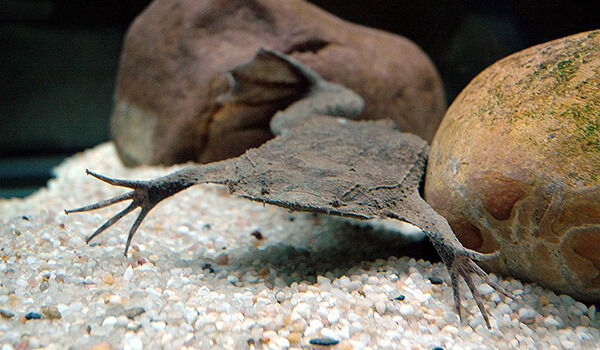
Photo: Suriname Pipa
Like many other tropical frogs, when water bodies become shallow or dry, the Surinamese pipa sits for a long period in dirty, shallow puddles or ditches, patiently waiting for better times to come. Frightened, the amphibian quickly dives to the bottom, burrowing deeper into the mud.
It is impossible not to dwell on the behavioral features of the hatched tadpoles. For example, strong tadpoles strive to reach the surface of the water as soon as possible and grab a bubble of life-supporting air. Weak “descendants”, on the contrary, fall to the bottom and float to the surface only after 2-3 attempts.
After their lungs open, tadpoles can swim horizontally. Moreover, at this stage they demonstrate flocking behavior – it is easier to escape from predators and get food. The frog, which previously laid eggs on its back, after the release of tadpoles, rubs against stones, wanting to remove the remnants of eggs. After molting, the sexually mature female is again ready for mating.
Feeding of tadpoles occurs starting from the 2nd day of their life. Their main diet (no matter how strange it may sound) is ciliates and bacteria, because by their type of nutrition they are filter feeders (like mussels). For feeding in captivity, nettle powder is optimal. Reproduction and development of Surinamese pipa occurs at T (under natural conditions) from 20 to 30 ° C and hardness not exceeding 5 units.
Social structure and reproduction
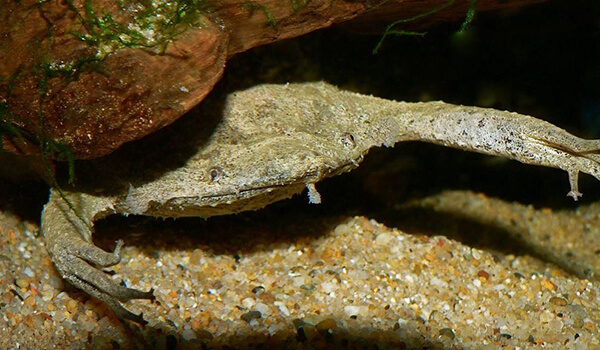
Photo: Surinamese pipa frog
The male makes specific clicking sounds during sexual activity, unambiguously hinting to the female that he is ready make her a pleasant and exciting time. The male and the female perform courtship dances directly under water (during this process, each other is “evaluated”). The female lays several eggs – in parallel with this, “her chosen one” pours them with his seminal fluid.
After that, the female dives down, where the fertilized eggs fall directly on her back and immediately stick to her. The male also takes part in this process by pressing the eggs to his partner with his hind legs. By joint efforts, they manage to evenly distribute them in the cells located along the entire back of the female. The number of eggs in one such clutch varies from 40 to 144.
The time during which the frog will bear its offspring is about 80 days. The weight of the “luggage” with eggs on the back of the female is about 385 grams – it is a very difficult task to carry around the clutch for pipa around the clock. The advantage of this format of caring for offspring lies in the fact that upon completion of the masonry formation process, it is covered with a dense protective membrane that provides reliable protection. The depth of the cells where the caviar is placed reaches 2 mm.
Staying, in fact, in the body of the mother, the embryos receive from her body all the nutrients they need for successful development. The partitions separating the eggs from each other are abundantly permeated with vessels – through them oxygen and nutrients dissolved in the eggs are supplied to the offspring. Somewhere in 11-12 weeks, young pips are born. Reaching puberty — only by 6 years old. The breeding season coincides with the rainy season. This is not surprising, because pipa loves water like no other frog.
Pip’s natural enemies
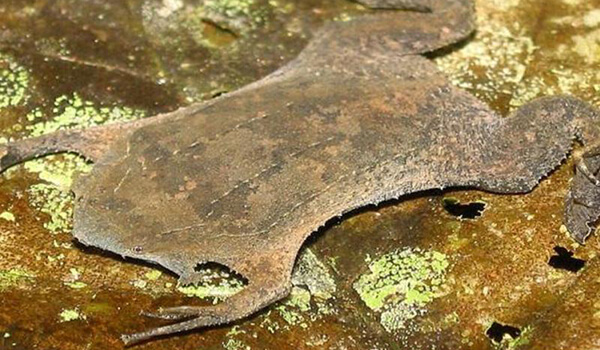
Photo: Suriname Pipa Toad
Pipa Surinamese is a real delicacy for tropical birds, terrestrial predators and larger amphibians. Regarding birds, representatives of the corvid, duck and pheasant families most often feast on these frogs. Sometimes they are eaten by storks, ibis, herons. Most often, these majestic and noble birds manage to grab the animal right on the fly.
But snakes, especially water snakes, pose the greatest danger to the Surinamese pipa (just like for all other toads living on any continent). Moreover, even excellent camouflage does not help them here – in hunting, reptiles are more guided by tactile sensations and the definition of heat radiated by living organisms. Large marsh turtles are also not averse to eating such a frog.
Moreover, if adults have at least some chance of saving their lives by quickly running away or hiding from the pursuer, then tadpoles are absolutely defenseless. Countless numbers of them die, becoming food for aquatic insects, snakes, fish and even dragonflies. By and large, every inhabitant of a tropical reservoir will “consider it an honor” to eat a tadpole.
The only secret of survival is the quantity – only the fact that once a female Surinamese pipa lays about 2000 eggs, saves the species from extinction and allows you to keep the number stable.
Population and species status
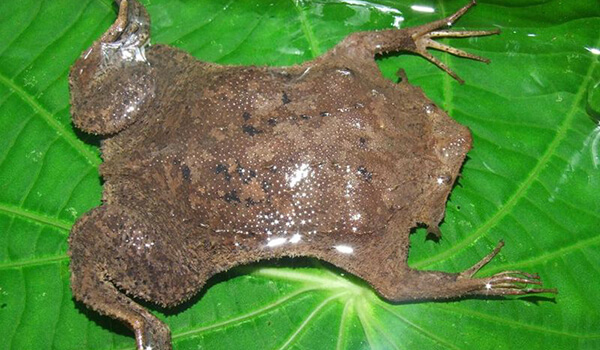
Photo: What a pipa looks like
The pipa is predominantly found in the South American river basin. These frogs can be seen in almost all countries of this continent. Some zoologists have noted the presence of these frogs in Trinidad and Tobago. Vertical Range Limit — up to 400 meters above sea level (that is, even at such a height there are Surinamese pips).
Despite the fact that the Surinamese pipa is officially classified as an amphibian, this frog is considered an obligate aquatic species – in other words, it constantly lives in water, which significantly limits the distribution of the species population. Pipa Surinamese prefers bodies of water with stagnant water or with a slow current – the range captures numerous river backwaters, as well as ponds and small forest ponds. Frogs skillfully hide in the fallen leaves, abundantly covering the bottom of the reservoir. Due to the fact that on land they move very clumsily and (unlike most other frogs) are not able to jump over long distances, individuals outside the water become easy prey.
Regarding the status of the species in nature, on Today, the number of Surinamese pipa and its dynamics is considered stable. Despite the large number of natural enemies and the influence of the anthropogenic factor, the species is often found within its own range. There is no threat to the abundance of this species, although in some places there is a decrease in populations due to human agricultural activities and significant deforestation of territories. Surinamese pipa is not included in the lists of endangered species, it is found on the territories of nature reserves.
Surinamese pipa differs from all other representatives of amphibians in many ways – only it does not have a long tongue intended for catching insects on its paws no membranes and claws. But she is perfectly camouflaged and, best of all amphibians, takes care of her offspring, carrying eggs on her back.

